It is generally believed that “trust property, as a kind of property that exists objectively in the legal relationship of trust, refers to the object of the legal relationship of trust, which is transferred by the trustor to the trustee through the act of trust, and is managed or disposed of in accordance with certain trust purposes.” Trust property is the object of the legal relationship of the trust as well as the material prerequisite for the realization of the trust, which is a necessary condition for the establishment of the trust. The core of a trust relationship is trust property. Trust relationships cannot exist without trust property.
“The existence of a trust is functionally a legal design for the realization of ‘property transfer’ and ‘property management’” based on the principle of being entrusted by others, loyal to others, and managing money for others. The foundation lies in the trust of the trustor to the trustee. Only when the trustor transfers the ownership of the trust property to the trustee can the mutual trust be proved to exist. From the perspective of the core functions of the trust system, if the trustee enjoys the ownership of the trust property, the preservation and appreciation of the trust property can be maximized and the financial management function of the trust system can be fully performed, adhering to its basic principles. At the same time, a series of measures such as trust contracts, the independence of trust property, and the legal obligation of loyalty and care can effectively play their preventive function.

Based on this, we believe that, on the one hand, in granting the trustee the ownership of the trust property, whether the trust property is transferred to the trustee is the key to the establishment of the trust. The trustee has all the powers and functions of possession, use, profit and disposal of the trust property. Compared with ownership in the general sense, the trustee’s ownership of the trust property does not and should not differ in appearance. However, it is different from the trustee’s inherent property in terms of acquisition methods and actual beneficial ownership.
On the other hand, the right of relief to the trustee or other related third parties should be granted to the beneficiary. If the trustee does not perform the trust obligations in accordance with the agreement, or if a third party illegally infringes on the trust property, which endangers the fundamental interests of the beneficiary, the beneficiary could claim the rights from the trustee or the third party, requesting it to stop the infringement, return the original property, and compensate for loss. Only by this can the independence of trust property be fully guaranteed, the bankruptcy isolation function of the trust be performed, and transaction security be maintained.



